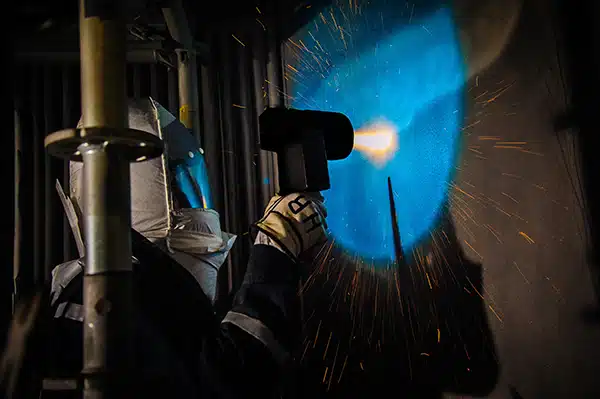How to Stop Corrosion on Your Refinery Distillation Column

Abstract
Repair and outage costs of a refinery Crude Distillation Unit (CDU) can be significant, involving the complexity of shell replacement or weld overlay and associated PWHT.
High Velocity Thermal Spray (HVTS) cladding technology has a well-documented history of shell protection in sour conditions where low, or locally low, pH results in material wastage. These modified superalloy systems are resistant to both caustic and acidic conditions at high temperatures.
They are effective in providing an impermeable metallurgical barrier, protecting the underlying substrate, and can be efficiently applied without impact to the existing shell or the need for post thermal processing. However, unlike many service pressure vessels found in upstream and refining, CDUs present unique challenges due to graduated temperature and corrosivity profiles, as well as the unique chemical characteristics of the feed, which can vary throughout the column.
Extensive testing was undertaken in corrosion autoclaves using raw crude oil obtained from functioning wells. These materials were characterized and enhanced in terms of corrosivity to mirror more aggressive feeds. Distinct corrosion and test environments were created to represent the differential CDU conditions. Read the full whitepaper to learn about the performance of modified HVTS systems for corrosion protection in the varied environment of a typical CDU column.
Introduction
Crude Distillation Units (CDUs) are mission critical units and often the primary bottleneck in refinery output and outage timelines. At their most basic, CDUs separate raw crude into useful fractions based on boiling point; these distillates are then further processed into refined products such as jet fuel, gasoline, kerosene, etc.
Following arrival from well sites, raw crude oil is typically pre-heated and desalted to remove water and inorganic salts; this reduces the corrosivity of crudes, however, many corrosives such as organic chlorides, naphthenic acids, and sulfides can remain. Desalted crude is then heated to approximately 350°C to 400°C and fed into to the primary CDU column, where specific fractions condense based on boiling point and flow out on condensation trays. Naphtha and light vapors travel to the top of the column before being drawn off via overhead lines.
Crude Distillation Units are indispensable to refinery operation; however, they are subject to corrosion attack from a variety of sources due to varied regional feeds and conditions.
Raw crude oil, especially “opportunity crudes” sourced from lower quality wells, is extremely corrosive due to elevated acid, salt, and sulfur content. Rapidly changing crude sources can result in an everchanging and varied regional corrosion environment.
Additionally, due to the vastly different temperature gradients and local fractionalized media, the sources and intensity of corrosion is variable throughout the column. Generally, however, there are two major sources of significant corrosion in CDUs: high temperature sulfidation and naphthenic acid corrosion on the column trays and walls, and overhead corrosion due to HCl condensation and amine/ammonia salts.
More corrosion and erosion management articles from Integrated Global Services:
CO₂ Corrosion Prevention and Control in Oil and Gas Production
How to Prevent Microbially Influenced Corrosion (MIC) with On-Site Alloy Upgrade
Why is High Emissivity Coating Durability Important in Fired Heaters?
Strategies for Preventing Internal Pipeline Corrosion in the Energy Industry
Flue Gas Dew Point Corrosion Mitigation: Alloy Upgrading Techniques
Mitigating Metal Dusting Corrosion in Ammonia and Methanol Reformers
Combating Flow Accelerated Corrosion in Power Plants with IGS HVTS Technology
Why an Alloy Upgrade is the Best Solution to Crude Unit Overhead Corrosion Control
Protecting Hydropower Turbines from Corrosion with HVTS Coatings
Protecting Offshore Wind Turbines – Splash Zone Corrosion
The Critical Role of High Emissivity Coatings in Space Exploration
Organic Coatings in Pressure Vessels: Internal Coating Failure Analysis
Causes of Boiler Corrosion and Benefits of Boiler Tube Coating
5 Common Causes of Refractory Failure and How to Fix Them
Boiler Tube Leaks Prevented with Proactive Maintenance
Understanding Oil & Gas CO2 and NOx Emissions, and the Science Behind Reducing Them
A Guide to Amine Stress Corrosion Cracking in Oil & Gas Processing
